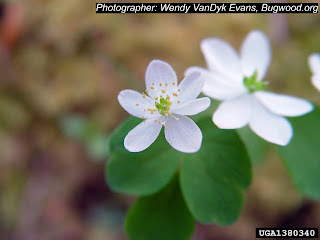 Georgia is the Rue anemone. First appearing in March, this delicate plant has a long bloom time – often into June, but becomes completely dormant in Summer. At full bloom this plant will only reach six to nine inches tall.
Georgia is the Rue anemone. First appearing in March, this delicate plant has a long bloom time – often into June, but becomes completely dormant in Summer. At full bloom this plant will only reach six to nine inches tall.Growing naturally on wooded slopes and ridges, this plant prefers part shade, but will tolerate full shade in acidic humus rich well drained soil. Found through out the east, Rue anemone extends west to Louisianna, Oklahoma, Kansas and Wisconsin. Threatened in New Hampshire and believed to be extirpated in Maine, there is also concern about this plant in Rhode Island and Florida. However, throughout the Piedmont and Blue Ridge Rue anemone is quite common.
Propagation is by division, root cuttings, or seed. However, seeds require cold moist stratification for three months to germinate well. Seedlings will take two to three years to flower, but this plant is worth the wait.
 Rue anemone may be most easily identified by the leaf structure. Though the leaves are sometimes described as whorled, what appears to be individual leaves may actually be three stemmed leaflets from an un-stemmed leaf. This would make the arrangement opposite instead of whorled. These rounded leaflets have three shallowly notched lobes on top and two where the stem is attached. The stems are dark and wiry in appearance and grow from a cluster of tuberous roots.
Rue anemone may be most easily identified by the leaf structure. Though the leaves are sometimes described as whorled, what appears to be individual leaves may actually be three stemmed leaflets from an un-stemmed leaf. This would make the arrangement opposite instead of whorled. These rounded leaflets have three shallowly notched lobes on top and two where the stem is attached. The stems are dark and wiry in appearance and grow from a cluster of tuberous roots.The flowers of Rue anemone are the most conspicuous feature. White flowers, occasionally tinged with pale pink display five to ten petal-like sepals (most often five) and up to fifteen greenish yellow stamens – each of which will produce a seed. Though flowers up to one inch across appear clustered, each has its own stem.
Formerly classified as Anemonella thalictroides by Linneas based on the umbelliform inforescences, it is now properly classified as Thalictrum Thalictroides and a member of the Crowfoot or Buttercup Family Ranunculaceae. Thalictrum is from the Greek thaliktron meaning a plant with divided leaves. The name is attributed to Dioscorides, the Greek physician and author of De Materia Medica the precursor of all modern pharmacopeias. Anemonella in Greek means small windflower in reference to the fact that this flower resembles a small anemone, and trembles at the slightest breeze. For this reason, the plant is also commonly called windflower.
A similar plant, False Rue Anemone (Isopyrum biternatum) is distinct in that the leaves present three separate lobes whereas the Rue Anemone leaflet is only slightly notched.
As always, I would be glad to hear any questions you might have, and to hear about your experience with this plant.


